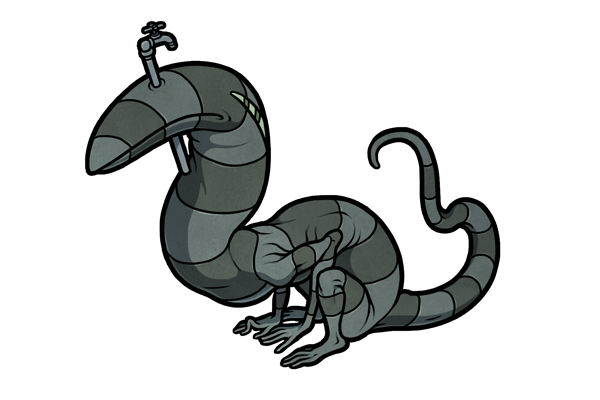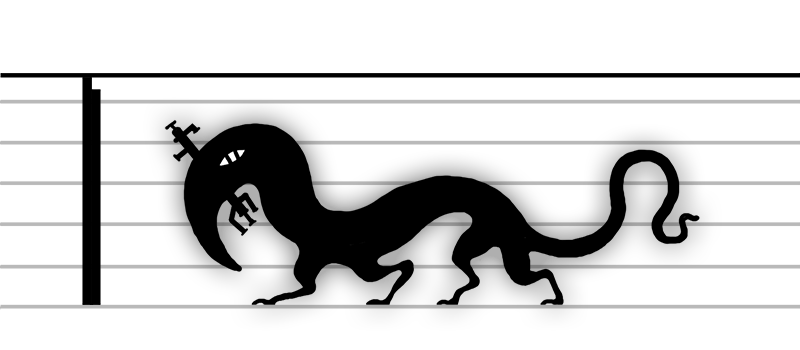

torodromi
the recreants
prefix toro suffix dromi
ipex subter
physical appearance
The torodromi /ˈtɔrədroʊmi/ is a slender, teal-colored stranger characterized by the metal pipe that pierces the head, neck, or body of mature individuals. The torodromi's skin, despite appearing soft, is clammy and rough, recalling the plasticine surface of a cheap child's toy. Its sludgy inner flesh coagulates upon contact with the air, but always remains more or less a liquid, dripping down from any cuts rendered. Its body cavity is otherwise filled with intestine-like structures of various sizes and shapes, which have a metallic sheen and are cool to the touch. The torodromi's odor is musty to the point of causing headaches or sinus infections following prolonged exposure.
The torodromi's regenerative ability is minimal, with even minor bruises spreading outward to cover large areas of its body. Cuts tend to remain open for weeks at a time, healing in murky, hardened patches upon the torodromi's surface. The torodromi's body also tends to become afflicted with a mold-like stain, most prominent around the hands, feet, and head. The torodromi's mouth and inner body, however, resist such discoloration and tend to remain healthy even in extremely damp and mildewy conditions.
deliberate silence.

environment and generation
The torodromi is found predominantly in damp, subterranean environments (appearing underground 96% of the time), such as sewers, underground waterways, buried reservoirs, and partially flooded basements. When occurring above-ground, the torodromi makes its home near cement-walled canals or artificial rivers, avoiding any natural bodies of water and, upon formation in these exterior locales, seeking out entranceways below ground whenever possible.
Its body coalesces from the grit and sludge that appears within its environment, this process a rapid one accompanied by a squelching slop. The torodromi appears in a prone position, and remains in this corpse-like posture for up to four months prior to its first shambling steps. Nearby torodromi often expedite this awakening with soft but effective nudging with the snout.
behaviour and effects
The torodromi's behaviour is morose and introverted. Skittish, it tends to shy away from light and loud sounds, preferring dim light. The mold that grows upon the torodromi's body seems to cause it some level of discomfort, and it shakes its body or scrubs its limbs with water in an ultimately futile attempt to clean itself. When it moves, its gait is slow and staggering, though not clumsy.
It is a social stranger, and groups of four to ten individuals tend to stay together within a small environment, often engaging in mutual grooming to pass the time. These groups make loose attempts at social hierarchies, with the oldest or largest individual typically directing the actions of its companions, its movements dictating periodic migration to new territories. The torodromi appears able to differentiate between individuals within its strain, and bases this distinction on appearances, treating an unknown stranger the same as a close friend, when meeting an individual of similar appearance.
pipe growth
The torodromi's characteristic pipe grows during the early stages of the stranger's life, starting off as a small bead of metal within the head, neck, or snout, and growing larger in wrenching expansions until it pierces through and out the skin. The flesh that is inside the pipe rots and eventually pours out, with others of the strain sometimes helping to clean out the exit point(s). The point at which the pipe enters the body does not tend to become afflicted with fungal growth.
While most torodromi grow quickly accustomed to this pipe, occasional scratching, head turning, or other neurotic behaviours do present immediately following the pipe's full expansion.
The vast majority of torodromi possess only one pipe, but a small minority (0.066% of individuals) grow a pair of pipes. These individuals are more aggressive than their single-piped brethren, and always become the dominant individuals within a group, using weak violence (such as slaps or scratches) to control their companions.
A minority of pipe-bearing torodromi (no more than 5% of individuals within an infested city) do display some overt curiosity towards nearby pipes of similar appearance, and push their head against the edges of these pipes in an attempt to connect with infrastructure. Unable to connect, these individuals eventually shed this behaviour entirely once several futile attempts have been made.
interactions with sensitives
The torodromi behaves as though unsure how to react to sensitives. It displays hesitant motions, alternating between stepping forward and pacing back, but does not touch sensitives. In addition, it reacts only when in very close proximity, completely ignoring any sensitive over eight feet away.
The torodromi avoids attacks, growing violent only as a last resort (and lacking any ability to cause more than light injuries), but does defend its companions from assault.
The torodromi causes both sensitives and non-sensitives in the area around its territory to feel the distant need to slightly flood the surroundings, a change so slight and easy to stave off that it barely passes into the conscious realm. Affected individuals may feel an idle desire to let the sink overflow when doing dishes, these urges generally not strong enough to act upon, and resulting in physical action only extremely rarely, and with no sense of reward or satisfaction upon doing so.
Over the span of four to seven decades, neighborhoods in torodromi-infested areas may become waterlogged and sink anywhere from one to fifteen inches into the earth.
aging and death
Although the torodromi staves off internal mold growth for the majority of its life, it is eventually poisoned by the same environment in which it lives, becoming stained by old age, with spores or more obvious fungal growths along the underside or at the point at which the pipe enters the skin in certain individuals. By the time it reaches this state, its somber demeanor grows mournful, the limp touches of its companions doing little to comfort it.
It dies in a secluded location, abandoned by its companions. Its body does not decompose readily, but instead grows leathery, tending to remain for many years. Other torodromi may take brief interest in their fallen companion's metal pipe, but otherwise, it is left to recede back into the sewers.



